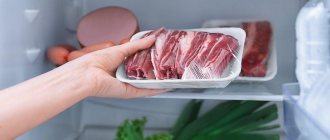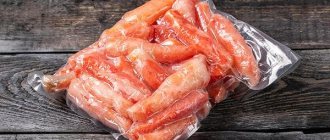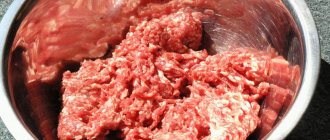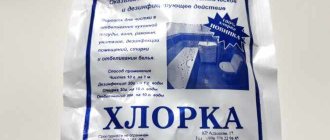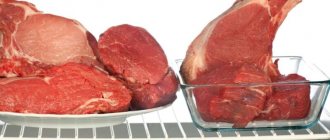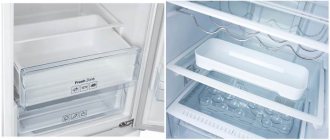If dinner needs to be served as quickly as possible and there is simply no time to slowly prepare the meat, a microwave oven will come to your aid. With its help, you can quickly and efficiently defrost even a very large piece of fillet. The main thing is to approach this issue correctly and follow all the simple rules of short-term defrosting.
How to properly defrost meat in the microwave: tips and tricks
One of the convenient and quick options for quickly defrosting meat products is the use of microwave ovens. These kitchen units, as a rule, have the specified function.
How to use this method correctly:
- remove a piece of meat from its packaging
- place it in a microwave-safe dish (glass or ceramic)
- cover with a lid
- place in the oven and set to “defrost”
- after 3 minutes, turn the product over
- microwave again on defrost mode for three minutes
- repeat similar manipulations until the meat is completely defrosted (about 3 - 4 similar cycles)
- After thawing, let the meat sit at room temperature for about half an hour
It should be noted that modern models themselves count down the thawing time and sound a beep when the meat needs to be turned over. And in some microwave ovens you need to enter the weight of the product into the program, set the desired mode, and the device itself will calculate the required time.
Defrosting in the microwave
It should be noted that this defrosting method, although quite fast, still has a number of significant disadvantages:
- The product is defrosting unevenly. This is especially true for large pieces or a whole poultry carcass, which has different meat thicknesses on different sides.
- food may have an unpleasant odor
- small pieces can simply be cooked
- the liquid from the product evaporates at an accelerated rate, and the dish ultimately turns out not so tasty and juicy
- You will need increased attention to the process in order to turn the piece over in time and not miss the right moment
- You should not resort to this method if the piece of meat is too large, as it will remain raw on the inside and dry out or baked on the outside.
As you can see, this thawing option is very controversial. Therefore, we advise you to use it only in an emergency.
Reheat the dough: do it right
It is better to defrost the dough in the microwave in a medium-depth saucer or plate. This way it will heat up more evenly - the top will quickly warm up in the deep part, but the dough in the middle will remain frozen.
The sheet dough needs to be thawed in a large flat plate (such as an Ardesto Bagheria) - the fewer folds there are, the better. This way it won't tear when you take it out while it's warm. It’s better to heat the flour like this:
- Turn on the microwave oven for 60-80 seconds. If you heat longer, the top edge of the dough will be baked.
- Turn the dough over and microwave for a minute . Repeat until the dough is soft.
- If the dough gets hot, let it cool. Usually up to 10 minutes is enough.
To prevent the yeast dough from weathering in the air, we recommend covering the plate with a napkin or cling film.
Simple science: How a microwave oven affects a person: 3 reasons not to be afraid
How to properly defrost meat in a slow cooker: tips and tricks
Increasingly, a useful and convenient device – a multicooker – takes its place of honor in the modern kitchen. Many housewives appreciated its capabilities. This household appliance also does an excellent job of defrosting meat.
How the process is carried out:
- place the meat, after removing its packaging, into the basket that is included in the package
- pour water into the bowl of the device
- set the device to “Steam cooking” mode
- do not cover with a lid
- after 8-20 minutes. (based on weight) the product will be defrosted
It is believed that this method allows the meat to preserve all its taste properties.
How to defrost meat in the oven?
Defrosting meat products in the oven has a number of advantages over other methods:
- defrosting occurs more evenly
- the process is significantly accelerated
- the meat inside the chamber does not become chapped or dry out
- the fibers retain their structure and meat juice does not leak out
Many modern models of ovens even have a defrosting function, which greatly facilitates the housewife’s work. In the event that your household appliances do not have such characteristics, meat can be defrosted in two ways.
Thaw meat in the oven
With temperature (accelerated method):
- Set the cabinet temperature to 30 degrees
- remove the packaging from the meat
- place in the oven for 8-10 minutes
- Check the defrost level periodically
Be careful not to overdo it with the temperature, otherwise your product will not thaw, but will bake: the inside will remain raw, and a crust will form on top.
Using convection (longer process):
- turn on the convection mode, if present on your device
- do not use the heating option
- place the product in the center of the rack
The fan creates air movement, which allows for more even defrosting. The product ultimately retains its beneficial qualities and is practically no different from fresh analogues.
Basic recommendations for thawing food in the oven:
- place the plate with meat on the grill
- It is better to use ceramic dishes
- you can cover the piece with some kind of bowl or plate - this will slow down the process a little, but the meat will turn out more tender and will not dry out
- Turn the product periodically for more even thawing.
In a steamer or oven
When defrosting with hot air, the internal structure of the product is not damaged.
I recommend selecting small pieces, then placing them on the lower tier of the multicooker and turning on the steam cooking mode. Gradually, as it thaws, the meat should be moved higher.
Using the same principle, you can defrost the product in the oven: just put it in a suitable container and set the heating temperature to about 35 degrees.
Unfortunately, when using this method, the meat will inevitably lose some of its juices, which will simply evaporate, and will be dry on the outside, but not yet thawed on the inside.
How to defrost meat in water?
Using water to defrost large pieces of meat or small semi-finished products is a common option for many housewives.
In this case, you can use different water.
Hot:
- place the meat in a sealable bag
- heat the water to about 60 degrees
- put the bag in a pot of water
- after 5-10 minutes, remove and place in a bowl of water at room temperature
- keep it like this for 20-25 minutes
In this way, a piece of pork weighing about a kilogram is defrosted within 30 - 40 minutes. It is possible that if the piece is large enough, the meat will not defrost completely and will not be suitable for cooking steaks or chops. However, for stewing, baking, etc., this method is quite acceptable.
Cold:
- place the wrapped meat in a deep container
- fill with ice water
- Additionally, you can add crushed ice to the bowl
- Change the water periodically to keep it cold or add new ice.
Defrosting meat in
salted water:
- meat must be removed from packaging
- make a concentrated solution of water and salt
- send a piece there
- wait 15-20 minutes
- When preparing the dish, keep in mind that the meat has already been salted
This method is accelerated due to the fact that salt activates heat exchange, and the product defrosts faster and more evenly.
Flow-through:
- place the meat product in a bowl
- place in the sink under the tap
- open the tap so that water (cold or warm) flows in a thin stream onto the meat
When using the methods listed above, keep in mind the general rules:
- defrost the meat in a bag so that the water does not affect the structure of the fibers
- in the case when products are defrosted without packaging, the water must be changed quite often (every 20 minutes), since microorganisms multiply quickly in it
- When defrosting the liver, add milk to the water - this will make it more tender.
Defrosting various types of meat - chicken, beef, pork, rabbit, barbecue meat
Each type of meat is defrosted using a specific technology. It will determine what the final taste of the finished dish will be, as well as how well the nutritional elements will be preserved.
We recommend reading —>>> Chicken cutlets in the oven
There are several recommendations in this regard:
- Beef (steaks, small pieces) is best defrosted in water heated to 40°C. As soon as the product becomes soft, it should be cooked immediately; if the meat is whole, then it is kept in cold water or waited for natural thawing in the refrigerator.
- Pork should not be kept in hot water, as this loses its juiciness, the finished dish becomes tough and becomes unappetizing and tasteless. If you need to start cooking urgently, it is better to use running tap water.
- To preserve the juiciness of the kebab, you need to place the meat pieces on a baking sheet, which have previously been placed in a sealed bag. And press them down with a pan of hot water on top. Thanks to the press and heat, the kebab will be ready for frying in just 15 minutes.
- The rabbit is defrosted using the same technology as chicken. If you need to do this quickly, you can put the carcass in salt liquid. Emergency methods of defrosting, this applies to household appliances and batteries, should be used only in exceptional cases when there is no other option. This is especially true for the most tender rabbit and chicken meat.
Which water is better to defrost meat: hot or cold?
To answer the question of what temperature water is best to defrost poultry or meat, you need to understand what is more important to you at the moment - the speed of thawing or the preservation of the beneficial properties of the product.
If you need to defrost meat as quickly as possible, then use warm water. Please note - not hot. Because high temperatures negatively affect the quality of meat and contribute to:
- protein breakdown
- active formation of harmful microorganisms and bacteria
- decreased taste of food
According to chefs, it is correct to defrost meat in very cold, even ice-cold water. This method is considered more useful and safer for the following reasons:
- the products remain fresh and practically do not lose their quality
- thawing occurs evenly to the very middle of the piece
- the product retains its juiciness
How to defrost meat in the refrigerator?
The most correct and useful method of defrosting any food, including meat, is to place it in the refrigerator. This preserves the nutritional value of all semi-finished products.
How to do it right:
- Without removing the packaging from the meat product, place it in a bowl so that moisture can drain there
- place in the refrigerator for a day on the shelf where the lowest temperature is maintained
- When the piece is almost defrosted, take it out and keep it at room temperature (this
- need to be done about a couple of hours before cooking)
- if you don’t have that much time, put the meat in water for 15 minutes
You can check how much liquid has collected in the plate after defrosting. The quality of the meat product is determined by its quantity - the less water, the faster and more correctly it was frozen.
Defrosting in the refrigerator
Remember that the meat must be thawed to room temperature before cooking. It is thanks to this:
- it will cook evenly
- the taste of the finished dish will be more tender and rich
- loss of vitamins will be reduced to a minimum
In cases where you have enough time, defrost the meat in the refrigerator. This is the most useful and safest method. In addition, as a bonus, you will save a little on electricity: the cold emanating from the ice product helps reduce the frequency of the compressor turning on.
How to defrost meat at room temperature?
Many people, in order to defrost pieces of meat, simply take them out of the freezer and leave them indoors. In principle, this method is quite effective and simple. However, it has significant disadvantages:
- Meat should not be left in the air for more than two hours to avoid creating favorable conditions for the proliferation of harmful bacteria.
- a piece weighing more than one and a half kilograms, defrosted to the middle, will become weathered on top and covered with an unpleasant film
Defrosting at room temperature
In order to avoid the above troubles, when using the specified option for defrosting meat products, follow these rules
- defrost food in a bowl to prevent any dripping liquid from staining the table
- cover with a kitchen towel
- choose not very large pieces
- Before starting the process, remove the protective packaging
- you can cover the meat in a plate with a warm rag (iron it or dip it in hot water and wring it out) - this will significantly speed up the result.
Ready meals and semi-finished products: 3 minutes and dinner is ready
Before placing food from the refrigerator in the microwave, you need to remove its protective packaging and place it in a microwave-safe container. It usually has a microwave oven icon on it.
Simply transfer the pizza and pancakes from the box to a plate of the appropriate size. If the dish does not fit in the oven, cut into several servings.
Following the advice, even those who have never done this before will be able to defrost food safely in the microwave.
By the way: How to choose the right microwave - instructions in 5 sections
How to speed up the defrosting of meat, how to quickly thaw meat: the fastest way
Despite the arguments of experts about the benefits of slowly thawing food, sometimes situations arise when we need to defrost ice-cold meat as quickly as possible. To speed up the thawing process, use the advice of experienced chefs:
- If the piece is wrapped in thick plastic, remove it. It is better to wrap the product in thin cling film or a bag, first releasing the air from there
- When the meat has thawed a little, cut it into smaller pieces - they will defrost much faster
- It is quite acceptable to defrost chopped meat or minced meat in a microwave or oven, since juiciness is not expected from it in the finished dish. And semi-finished products in the form of cutlets or meatballs don’t need to be thawed at all, but you can start cooking right away (start by frying until crusty, and then finish cooking in the oven)
Many Internet users speak positively about the emergency method of defrosting meat, the essence of which is as follows:
- heat the water to 52 degrees
- put a piece of meat there wrapped in thin plastic
- stir the water - this is a very important condition, since the meat thaws precisely thanks to the circulation of the liquid
Unfortunately, this method cannot be called very convenient, since it is difficult to heat the water exactly to 52 degrees. In addition, the need to constantly stir the water deprives a person of the opportunity to do other things.
Defrost meat quickly
A more reliable method seems to be proper freezing of products, which will subsequently speed up the thawing process:
- Before storing in the freezer, cut pieces of meat into small portions
- For convenience, sign all food packages
- Fresh minced meat is stored for no more than a day, since the process of reproduction of microorganisms in minced meat occurs at an accelerated pace. You need to freeze it in small portions, putting it in a bag and rolling it out (this way you can compactly mark it out in the freezer, and then thaw it faster)
- Wash large pieces of meat first in water, then dry and only then pack in plastic
- freeze food at maximum power (many modern units have a “super freeze” option)
Of course, cooked fresh meat has excellent taste and greater juiciness. However, in most cases, when tasting a dish, a person has no idea that the product was previously frozen if all thawing rules are followed.
Principles you need to know
- To preserve the natural taste of the semi-finished meat product, it should be defrosted as slowly as possible. The main rule of cooking is to freeze quickly and defrost as slowly as possible.
- During defrosting, the product must be in an airtight container. This way its taste is preserved, and most importantly, the lack of oxygen will stop the proliferation of pathogenic microflora. The absence of direct contact with water is important so that, together with it and the melting ice, the meat does not release its own juices, with all the ensuing consequences for the finished dish.
- Exposure to too high a temperature will brown the top layers, making them tasteless and overly tough during cooking. In this case, the internal parts will remain frozen. Such heterogeneity will also affect the quality of the finished dish.
- Thawed semi-finished products (pork, beef, veal) can be stored in the refrigerator for 2-3 days, poultry for 1-2 days. Its quality will not be affected provided that the original packaging remains sealed and is also wrapped in a towel.
- Repeated freezing is strictly not recommended. The product will lose not only all its beneficial properties, but even its visual appeal (it will look like a rag and fall apart into pieces).
From the above, we can draw the first conclusion that using advanced kitchen appliances in the form of ovens, microwaves, and multicookers for defrosting is extremely undesirable: these methods do not pose a health hazard, but the quality of the finished dish will significantly decrease. Therefore, you should resort to them only in the most extreme cases, when, as they say, “guests are on the doorstep.”
